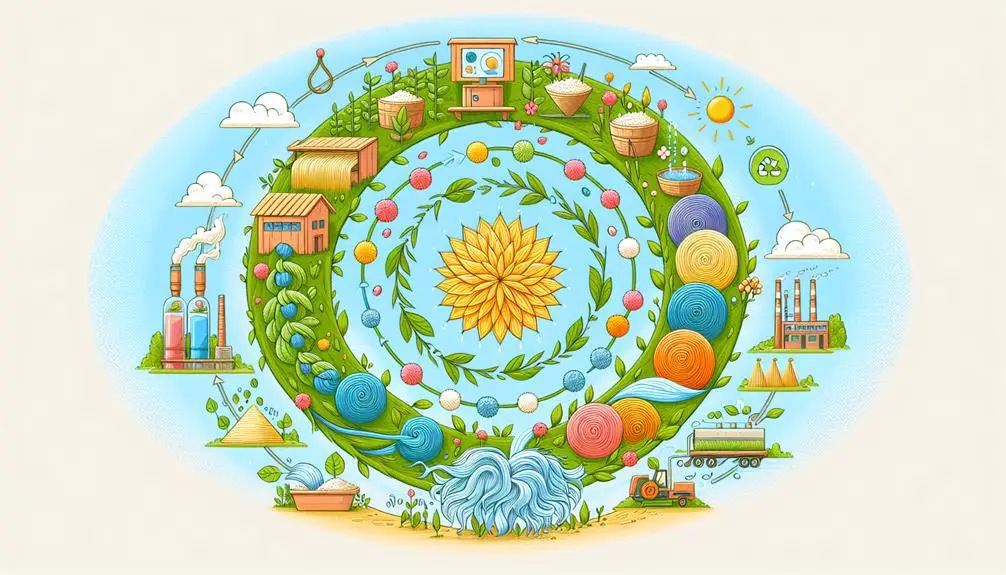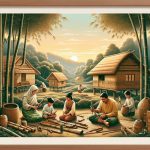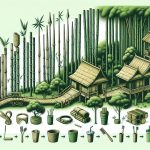Imagine your preferred shirt crafted from bamboo or organic cotton, not just fashionable but also sustainable. The journey of eco-conscious textiles begins with selecting natural, renewable materials that are gentle to our planet. You might ponder how sustainable farming practices and eco-conscious manufacturing play a role, lessening environmental impact from the outset. Then, there's the fascinating aspect of green dyeing processes, which utilize natural sources and low-impact techniques. What about the ethical labor practices that guarantee equitable treatment of workers? The lifecycle of these textiles is a complete narrative of sustainability, from beginning to end.
Table of Contents
Key Takeaways
- Sustainable Sourcing: Utilize renewable resources like organic cotton and bamboo to minimize environmental impact.
- Eco-Friendly Manufacturing: Implement energy-saving production methods and waste minimization strategies.
- Natural Dyeing: Use plant-based pigments and low-impact dyeing techniques.
- Water Conservation: Employ rainwater collection, efficient irrigation, and greywater recycling.
- Recycling and Disposal: Opt for upcycling, composting natural fibers, and researching recycling options to reduce landfill waste.
Raw Material Sourcing
When sourcing raw materials for eco-conscious textiles, prioritize natural and renewable resources like organic cotton and bamboo. By choosing these materials, you're guaranteeing that your textiles are both sustainable and biodegradable. Organic cotton, for instance, reduces the environmental impact since it's grown without harmful pesticides or synthetic fertilizers. Bamboo, recognized for its rapid growth and low water usage, makes an excellent alternative to conventional fabrics.
To achieve mastery in raw material sourcing, it's essential to take into account the entire supply chain. Trace the origins of your materials to make sure they align with eco-friendly principles. This involves verifying that the farms or plantations follow ethical practices. Fair trade certification is vital; it ensures that workers are paid fairly and work in safe conditions. By supporting fair trade, you're not only promoting social justice but also encouraging sustainable farming practices.
Streamlining your supply chain for efficiency and transparency is another important aspect. Work with suppliers who share your eco-friendly values and can provide documented proof of sustainability. This ensures that every step, from harvesting to processing, minimizes environmental impact and adheres to high ethical standards.
Sustainable Farming Practices
When considering sustainable farming practices for eco-friendly textiles, you should focus on organic crop rotation and water conservation techniques.
These methods help maintain soil health and reduce water usage, ensuring a smaller environmental footprint.
Organic Crop Rotation
Rotating crops organically boosts soil health and reduces pest infestations, making your farming practices more sustainable. By alternating the types of crops you plant, you're not only preventing soil depletion but also enhancing its nutrient profile. This practice increases soil health, a critical component for cultivating high-quality, eco-friendly textiles. In addition, organic crop rotation promotes carbon sequestration, trapping carbon dioxide in the soil, which mitigates climate change.
To effectively implement organic crop rotation, consider the following:
- Diversify Crop Selections: Plant a variety of crops that have different nutrient requirements and pest resistances. This diversity disrupts pest cycles and reduces the risk of infestations.
- Legume Integration: Incorporate legumes like beans and peas into your rotation plan. These plants naturally fix nitrogen in the soil, enriching it for subsequent crops and reducing the need for synthetic fertilizers.
- Strategic Planning: Rotate crops in a sequence that maximizes soil fertility and minimizes disease. For example, follow nitrogen-fixing legumes with high-nutrient-demanding crops like cotton.
Water Conservation Techniques
Building on the benefits of organic crop rotation, implementing water conservation techniques can further enhance the sustainability of your farming practices.
Start with rainwater harvesting; it allows you to capture and store rainwater for future use, reducing reliance on municipal water supplies. Efficient irrigation methods, like drip systems, deliver water directly to plant roots, minimizing evaporation and runoff. This precision guarantees your crops receive the right amount of water, enhancing growth and conserving resources.
Consider greywater recycling to reuse water from household activities like laundry and dishwashing. By treating and repurposing this water for irrigation, you reduce overall water consumption and promote a closed-loop system.
Drip systems, integrated with greywater, create an optimized irrigation method that sustains your crops while conserving precious water resources.
Adopting these techniques not only supports eco-friendly textiles but also demonstrates a commitment to sustainable farming. Your mastery of rainwater harvesting, efficient irrigation, greywater recycling, and drip systems will make your agricultural practices a model of environmental stewardship.
Eco-Friendly Manufacturing
Eco-conscious manufacturing prioritizes sustainable practices and materials to reduce environmental impact in the textile industry. By adopting energy saving production and waste reduction strategies, you can greatly lower the ecological footprint of textile manufacturing. These strategies not only conserve resources but also contribute to a healthier planet.
Understanding and implementing carbon footprint analysis is essential. This involves measuring the total greenhouse gas emissions produced throughout the manufacturing process. With this data, you can pinpoint areas for improvement and develop a more sustainable supply chain. Analyzing each step guarantees that every link in the chain aligns with your sustainability goals.
Here's how you can integrate eco-friendly manufacturing practices:
- Energy Saving Production: Invest in machinery and processes that consume less energy. This includes using renewable energy sources like solar or wind power.
- Waste Minimization Strategies: Implement techniques to reduce waste, such as recycling offcuts and using biodegradable materials.
- Sustainable Supply Chain: Choose suppliers dedicated to sustainability, ensuring that raw materials are responsibly sourced and that ethical labor practices are upheld.
Green Dyeing Processes
When you consider green dyeing processes, you'll find that natural dye sources are just the beginning.
You can also explore low-impact techniques that reduce environmental harm to a great extent.
Plus, water conservation methods play an important role in making dyeing more sustainable.
Natural Dye Sources
Exploring natural dye sources reveals a vibrant world of sustainable options for creating eco-friendly textiles. You'll find that plant based pigments and traditional methods offer both beauty and environmental benefits.
Natural dyeing processes use resources like leaves, roots, and flowers to produce rich and diverse colors, proving to be sustainable alternatives to synthetic dyes.
Here are three notable natural dye sources you should consider:
- Indigo: Derived from the indigofera plant, this dye has been used for centuries to create deep blue hues. It's a staple in many cultures, demonstrating the enduring appeal of plant based pigments.
- Madder Root: This ancient dye source offers a range of red shades. Madder root has been a favorite in traditional methods for its vibrant color and historical significance.
- Turmeric: Known for its bright yellow pigment, turmeric isn't only a staple in kitchens but also in the world of natural dyeing. It's an excellent sustainable alternative for achieving sunny, warm tones.
Low-Impact Techniques
Utilizing low-impact methods in dyeing processes greatly diminishes environmental harm while still producing vibrant textiles. When you embrace chemical-free processing, you eliminate harmful toxins that can seep into ecosystems. Instead, you can opt for natural dyes derived from plants, minerals, and even insects, offering a rich palette of colors without the ecological footprint of synthetic dyes.
Incorporating energy-efficient practices into your dyeing process is essential for eco-conscious production. You can achieve this by using low-temperature dye baths and innovative machinery that require less energy. These methods not only reduce greenhouse gas emissions but also lower your operational costs, making sustainable choices economically viable.
Adopting a minimal waste approach is another key strategy. By employing precise measuring techniques and recycling dye baths, you can guarantee that every drop of dye is utilized effectively. This minimizes waste and reduces the burden on wastewater treatment facilities.
Additionally, you can explore dyeing techniques like digital printing, which uses considerably less water and dye compared to traditional methods.
Water Conservation Methods
In the world of green dyeing processes, conserving water is paramount to creating truly sustainable textiles. You can implement several methods to guarantee water conservation while maintaining high dyeing standards. By adopting these strategies, you not only save water but also contribute to the overall sustainability of the textile industry.
First, consider rainwater collection as a primary source for your dyeing processes. Collecting and storing rainwater reduces reliance on municipal water supplies and provides a renewable, cost-effective resource.
Second, utilize reclaimed water recycling systems. By reusing wastewater from previous dyeing processes, you minimize freshwater consumption and reduce the environmental impact of textile production.
Third, optimize your supply chain by focusing on watering efficiency. Partner with suppliers who grow drought-tolerant crops, which require less water and thrive in arid conditions. This approach ensures a sustainable raw material supply while conserving water resources.
Implementing these methods can significantly lessen your water footprint and set a benchmark for eco-friendly textile production. By mastering these water conservation techniques, you're not only improving your operations but also leading the charge toward a more sustainable future.
Ethical Labor Practices
Ethical labor practices guarantee workers in the textile industry are treated fairly and work in safe conditions. By prioritizing fair trade, you're ensuring that the people who produce your textiles receive fair wages, work reasonable hours, and have access to essential benefits. Fair trade certifications also signify that these workers are operating in environments free from child labor and forced labor, thereby upholding the highest ethical standards.
Understanding worker rights is essential when diving into the world of eco-friendly textiles. These rights include the freedom to join unions, the right to safe and healthy working conditions, and the assurance that workers can raise concerns without fear of retaliation. By supporting companies that prioritize these rights, you're contributing to a more just and equitable industry.
When you choose eco-friendly textiles, you're not just making an environmentally sound choice; you're also endorsing ethical practices that elevate the lives of workers. Brands committed to these practices often provide transparent supply chains, allowing you to trace the journey of your textile from raw material to finished product. This transparency empowers you to make informed decisions, ensuring that your purchasing habits align with your ethical values.
Consumer Use and Care
When you invest in eco-friendly textiles, knowing how to properly use and care for them guarantees they last longer and maintain their quality.
To create a sustainable wardrobe, you need to integrate eco-friendly laundry practices and thoughtful maintenance habits.
- Wash Less Frequently
Overwashing reduces the lifespan of your clothes. Spot-clean when possible and air out garments to minimize washing. This conserves water and energy, aligning with sustainable fashion goals.
- Choose Gentle Detergents
Use eco-friendly detergents free from harsh chemicals. These protect the fibers of your textiles and prevent harmful substances from entering waterways. Opt for cold washes to reduce energy consumption and further prolong the life of your garments.
- Mindful Drying Techniques
Air-dry whenever possible. Tumble drying can degrade fabric quality and consume significant energy. If you must use a dryer, select a low-heat setting. This practice helps maintain the integrity of your textiles and supports a more sustainable wardrobe.
Recycling and Upcycling
Transforming old or unwanted textiles into new, valuable items is a fantastic way to reduce waste and embrace creativity. By engaging in recycling and upcycling, you'll not only contribute to waste reduction but also tap into a world of artistic redesign and eco-conscious fashion.
Instead of discarding old garments, consider how they can be creatively repurposed. A worn-out T-shirt can become a stylish tote bag, or faded jeans can be transformed into chic shorts.
Creative repurposing allows you to breathe new life into items that might otherwise end up in landfills. You're not just recycling; you're reimagining and redesigning. This approach to textiles empowers you to take control of your wardrobe in a sustainable way, reducing your environmental footprint.
The art of upcycling requires a keen eye for potential and a willingness to experiment, which can be incredibly fulfilling.
Moreover, eco-conscious fashion isn't just a trend; it's a responsibility. By embracing artistic redesign, you're setting an example for others, encouraging a shift towards more sustainable practices.
Through innovative recycling and upcycling, you can create unique pieces that reflect your style and commitment to the planet.
End-of-Life Disposal
While recycling and upcycling breathe new life into textiles, understanding end-of-life disposal guarantees that unusable items don't harm the planet. You should evaluate the landfill impact and consider recycling options.
Unmanaged disposal in landfills contributes to pollution and greenhouse gas emissions. Instead, explore these responsible disposal methods:
- Recycling Options: Research local facilities that accept textile waste. Many can break down fibers and repurpose them for new products. This process reduces landfill impact and conserves resources.
- Biodegradability Rate: Choose textiles made from natural fibers like cotton, wool, or hemp. These materials have a higher biodegradability rate compared to synthetic fibers and break down more quickly in the environment. Prioritize eco-friendly textiles to minimize long-term waste.
- Composting Solutions: For textiles made from 100% natural fibers, composting is a viable option. Cut the fabric into small pieces to accelerate decomposition and mix it with other compostable materials. This method enriches the soil and reduces landfill burden.
Frequently Asked Questions
How Do Eco-Friendly Textiles Compare in Cost to Conventional Textiles?
Imagine a double-edged sword: eco-friendly textiles often cost more upfront, but their lower environmental impact can save you money and resources in the long run. This cost comparison favors sustainability over short-term savings.
What Certifications Should I Look for in Eco-Friendly Textiles?
When choosing eco-friendly textiles, you should look for certifications like GOTS for organic production and FSC for sustainable sourcing. These certifications guarantee the materials meet stringent environmental standards, reflecting your commitment to sustainability.
Are There Any Health Benefits to Using Eco-Friendly Textiles?
You'll find health benefits and wellness benefits with eco-friendly textiles. These materials reduce environmental impact and offer sustainability advantages. They're often free of harmful chemicals, promoting a healthier lifestyle for you and the planet.
How Can I Identify Genuine Eco-Friendly Textiles in the Market?
Exploring the textile jungle, you'll need a keen eye. Look for eco-friendly textile certifications like GOTS and OEKO-TEX. Identifying sustainable fabrics requires checking labels and verifying credentials—your compass to authentic, green choices.
Do Eco-Friendly Textiles Offer the Same Durability as Traditional Fabrics?
You might wonder about the durability comparison between eco-friendly textiles and traditional fabrics. Often, eco-friendly options match or exceed durability while reducing environmental impact to a considerable extent, making them a wise, sustainable choice for long-lasting use.
- Jaclyn Smith Fabric Coconut: a Review of This Rayon/Polyester Blend - June 29, 2025
- Jaclyn Smith Fabric Coconut: a Review of This Rayon/Polyester Blend - June 29, 2025
- How to Get Coconut Oil off Fabric Without Washing - June 29, 2025







